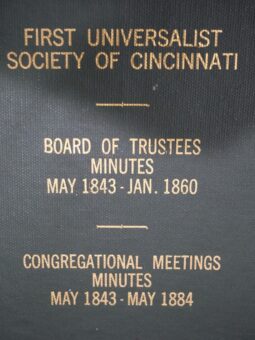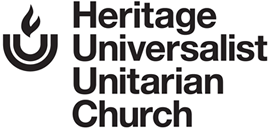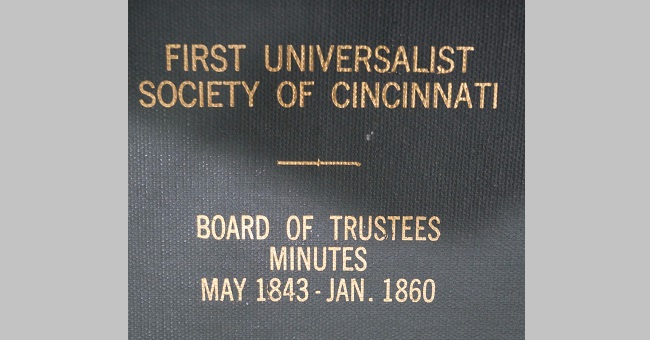by Mike Roberts, Church Historian
The earliest written record from our archives are the minutes from an annual meeting held on May 1, 1843. “The annual meeting of the Society for the election of officers for the ensuing year was held on this evening. The meeting was called to order by Brother Morse and proceeded to elect five trustees, treasurer, clerk and three stewards when the following brethren were duly elected to fill the respective offices. Griffin Yeatman, Henry Morse, R. A. Madison, Thomas H. Johnson and Samuel H. Harwick trustees. R. H. Moorhead, treasurer, B. R. Alley, Clerk, David Cotton, James Davis, and Samuel Halley, stewards. Brothers Yeatman, Morse and Johnson, trustees elect being present were affirmed faithfully to discharge the duties of trustees of the Society by E. Harrison, Esq. when the Society on motion adjourned.”
The name Griffin Yeatman stands out from these early church pioneers. There is no strong evidence that this is the same Griffin Yeatman who was a prominent resident of Cincinnati in its early years of existence. However, the only men of this name who lived in the city were the elder Griffin and his son. The time of his service to the church would seem to point to the elder Griffin Yeatman as his son was but 27 years old in 1843.
Yeatman came to Cincinnati in 1793 and built the largest tavern in the city, the Square and Compass. It had more than just drinks to serve, with a dining room and upstairs rooms for meetings. It was probably the most prominent gathering place in the early city. Among the visitors to the tavern were Lafayette, Anthony Wayne, William Henry Harrison, George Rogers Clark, Aaron Burr and Andrew Jackson. The tavern sat at the foot of Sycamore Street and the park and landing there today is known as Yeatman’s Cove. Eventually, Yeatman built an inn next to the tavern called the “Hotel de Ville” or “Yeatman’s Inn.” He was also elected to several offices in city government and served 27 years as the Hamilton County Recorder. To this day, an award is given by the recorder’s office that bears his name.
The business that is recorded in 1843 was mostly mundane. Bills were paid and the day-to-day operation of the church was discussed. Bills paid at one meeting in November included a Cincinnati Gas bill for $9.04. R. H. Morehead was reimbursed $97.75 for stoves purchased for the church. I. N. Frisby was reimbursed for $3.75 for “sundries.”
One issue that was to plague the church for 40 years arose in those 1843 meetings. This involved the renting of pews. This practice was the lifeblood of the church’s financial stability. It was a practice that dated back centuries in England and had been brought to Protestant churches in New England during the colonial period. However, by 1843, it had probably outlived its time but it was not until the 1880’s that our church abandoned pew rentals. Non-payment and the inability to rent all of the pews were constant subjects of meeting over that 40-year period. $250 was the most expensive annual pew rental and the cheapest were $40. The difference in price was determined by the location of the pew.
On December 6, 1843, the Board of Trustees issued their findings regarding an attack on the moral reputation of one Mary Campbell. The investigation was requested by Mary Campbell herself and conducted by an appointed committee. The statement in the board minutes is as follows. “Upon diligent inquiry and examination they can not find that she has been guilty of any immoral or improper conduct in the least. But, on the other hand that she does sustain a good and unsullied reputation, and as such, would commend her to the sympathies of this Society. We forebear saying anything further upon the foul and malignant slanders (as we believe them) that have been propagated against her as the matter is submitted to a legal investigation where we doubt not that justice will be meted out to the guilty—all of which is respectfully submitted.” E. Singer, Chairman of the Committee.
It was also decided at this meeting that the trustees be instructed to apply immediately to the Ohio Legislation for a charter for the Society. This act would have been undertaken almost 15 years after the formation of the church.


